

Compact Muon Solenoid
LHC, CERN
| CMS-PAS-HIG-17-019 | ||
| Search for the standard model Higgs boson decaying to two muons in pp collisions at $\sqrt{s}= $ 13 TeV | ||
| CMS Collaboration | ||
| November 2017 | ||
| Abstract: A search for the standard model (SM) Higgs boson decaying to two muons is presented using data recorded by the CMS experiment at the LHC in 2016 at a center-of-mass energy of 13 TeV, corresponding to an integrated luminosity of 35.9 fb$^{-1}$. Limits are set on the cross section of the Higgs boson decaying to two muons for mass hypotheses between 120 and 130 GeV. For a Higgs boson with a mass of 125 GeV decaying to two muons, the 95% confidence level (CL) observed (expected) upper limit on the production rate is found to be 2.64 (2.08) times the SM value. The combination with data recorded at center-of-mass energies of 7 and 8 TeV yields a 95% CL observed (expected) upper limit of 2.64 (1.89) times the SM value. This corresponds to an upper limit on the Higgs boson branching fraction to muons of 5.7$ \times 10^{-4} $, assuming the SM production cross sections. | ||
|
Links:
CDS record (PDF) ;
inSPIRE record ;
CADI line (restricted) ;
These preliminary results are superseded in this paper, PRL 122 (2019) 021801. The superseded preliminary plots can be found here. |
||
| Figures | |

png pdf |
Figure 1:
The transformed BDT output distribution in data and MC. The stacked solid histograms represent the background processes, while the stacked empty histograms represent the signal distributions. The solid circular markers are the data and the statistical error associated to them. |
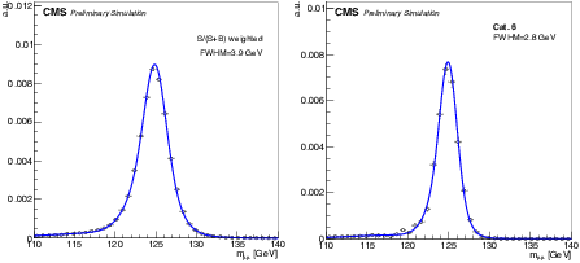
png pdf |
Figure 2:
Signal model compared to MC predictions, weigthed sum of the contribution from all process and all categories (left), and for one of the best mass resolution, category 6, (right) normalised to unity. |
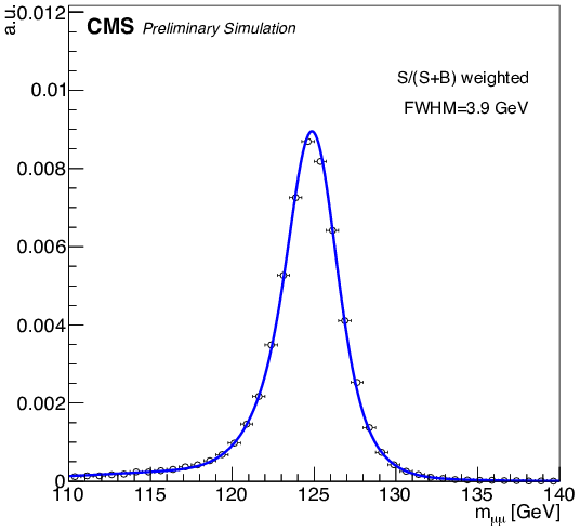
png pdf |
Figure 2-a:
Signal model compared to MC predictions, weigthed sum of the contribution from all process and all categories (left), and for one of the best mass resolution, category 6, (right) normalised to unity. |
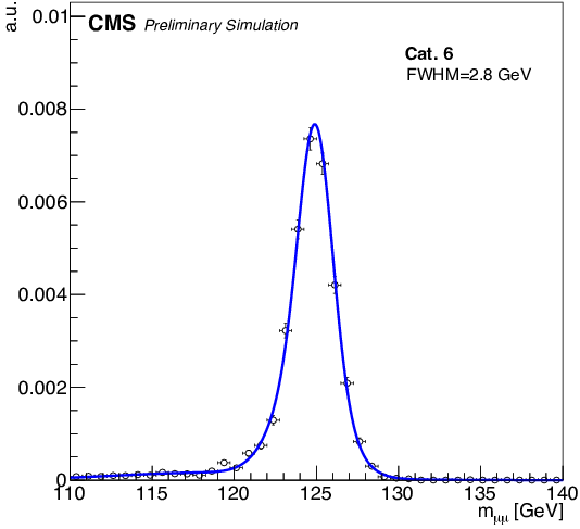
png pdf |
Figure 2-b:
Signal model compared to MC predictions, weigthed sum of the contribution from all process and all categories (left), and for one of the best mass resolution, category 6, (right) normalised to unity. |
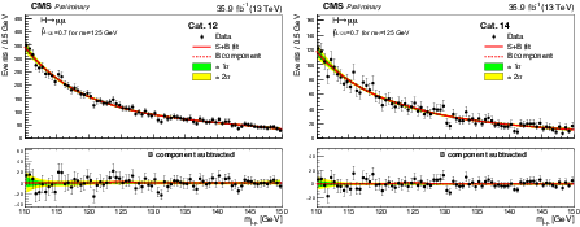
png pdf |
Figure 3:
Signal-plus-background (S+B) fit (solid) and the background-only (B) component (dashed) of the dimuon mass spectrum in events from category 12 (left) with the Modified Breit-Wigner multiplied by a Bernstein polynomial (degree 4) as the functional form and category 14 (right) with the Modified Breit-Wigner functional form. The bottom panels show the dimuon mass spectrum with the fitted background component subtracted (B component subtracted). |
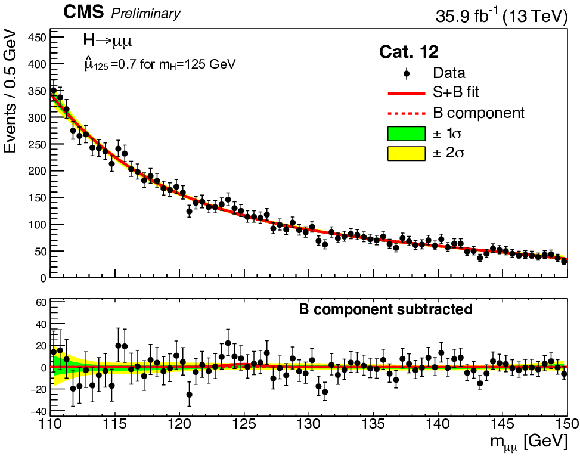
png pdf |
Figure 3-a:
Signal-plus-background (S+B) fit (solid) and the background-only (B) component (dashed) of the dimuon mass spectrum in events from category 12 (left) with the Modified Breit-Wigner multiplied by a Bernstein polynomial (degree 4) as the functional form and category 14 (right) with the Modified Breit-Wigner functional form. The bottom panels show the dimuon mass spectrum with the fitted background component subtracted (B component subtracted). |
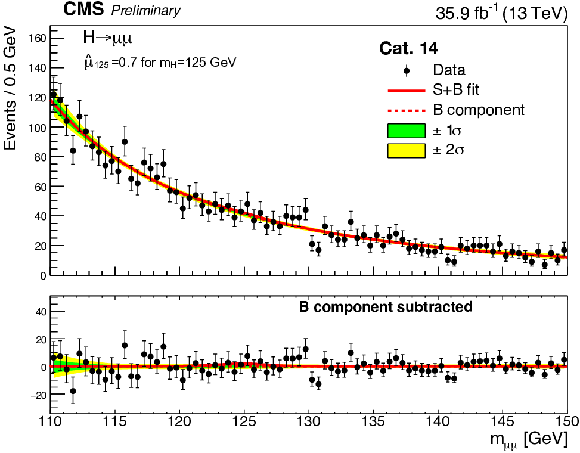
png pdf |
Figure 3-b:
Signal-plus-background (S+B) fit (solid) and the background-only (B) component (dashed) of the dimuon mass spectrum in events from category 12 (left) with the Modified Breit-Wigner multiplied by a Bernstein polynomial (degree 4) as the functional form and category 14 (right) with the Modified Breit-Wigner functional form. The bottom panels show the dimuon mass spectrum with the fitted background component subtracted (B component subtracted). |
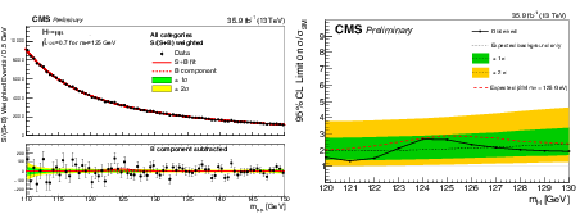
png pdf |
Figure 4:
The weighted sum of individual fits to each category of the signal-plus-background fits (solid) and the background-only components (dashed). Events are weighted according to the expected signal-to-background ratio in the category to which they belong (left). The 95% CL upper limit on the signal strength modifier, $\mu $, for 13 TeV pp collisions data collected in 2016 together with the expected limit obtained in the background hypothesis and signal-plus-background hypothesis (red line) for a SM Higgs boson with $ {m_\mathrm{H}}= $125 GeV (right). |
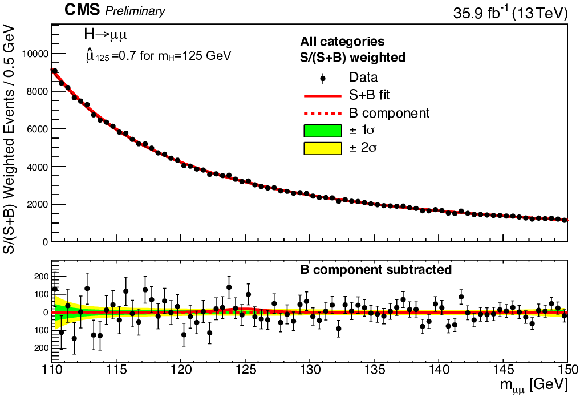
png pdf |
Figure 4-a:
The weighted sum of individual fits to each category of the signal-plus-background fits (solid) and the background-only components (dashed). Events are weighted according to the expected signal-to-background ratio in the category to which they belong (left). The 95% CL upper limit on the signal strength modifier, $\mu $, for 13 TeV pp collisions data collected in 2016 together with the expected limit obtained in the background hypothesis and signal-plus-background hypothesis (red line) for a SM Higgs boson with $ {m_\mathrm{H}}= $125 GeV (right). |
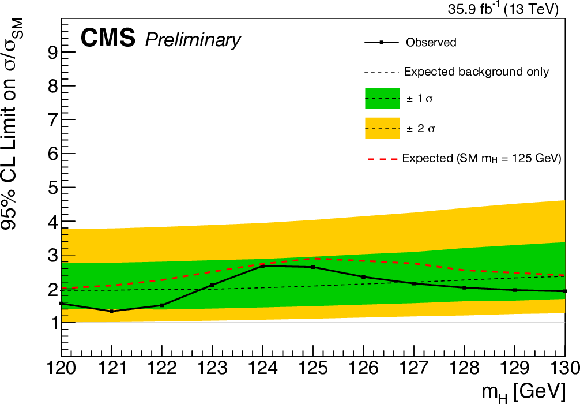
png pdf |
Figure 4-b:
The weighted sum of individual fits to each category of the signal-plus-background fits (solid) and the background-only components (dashed). Events are weighted according to the expected signal-to-background ratio in the category to which they belong (left). The 95% CL upper limit on the signal strength modifier, $\mu $, for 13 TeV pp collisions data collected in 2016 together with the expected limit obtained in the background hypothesis and signal-plus-background hypothesis (red line) for a SM Higgs boson with $ {m_\mathrm{H}}= $125 GeV (right). |
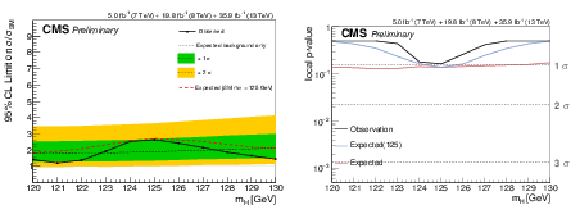
png pdf |
Figure 5:
The 95% CL upper limit on the signal strength modifier, $\mu $, for the combination of the 7, 8, and 13 TeV datasets (left) together with the expected limit obtained background hypothesis and in the signal-plus-background hypothesis (red-line) for a SM Higgs boson with $ {m_\mathrm{H}}= $ 125 GeV. The combined local p-value and significance as a function of the SM Higgs boson mass hypothesis (right). The observation (black) is compared to the expectation (red) for the Higgs boson, and (blue) for the Higgs boson mass of 125 GeV. |
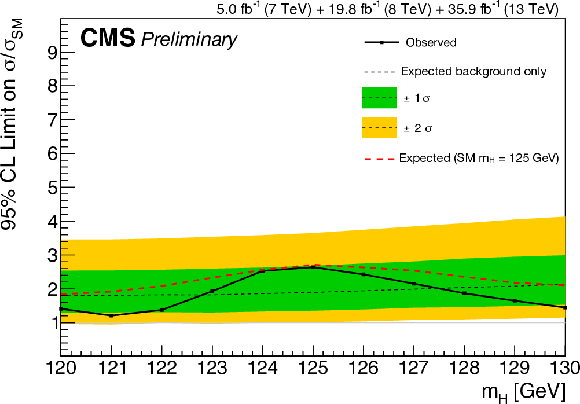
png pdf |
Figure 5-a:
The 95% CL upper limit on the signal strength modifier, $\mu $, for the combination of the 7, 8, and 13 TeV datasets (left) together with the expected limit obtained background hypothesis and in the signal-plus-background hypothesis (red-line) for a SM Higgs boson with $ {m_\mathrm{H}}= $ 125 GeV. The combined local p-value and significance as a function of the SM Higgs boson mass hypothesis (right). The observation (black) is compared to the expectation (red) for the Higgs boson, and (blue) for the Higgs boson mass of 125 GeV. |
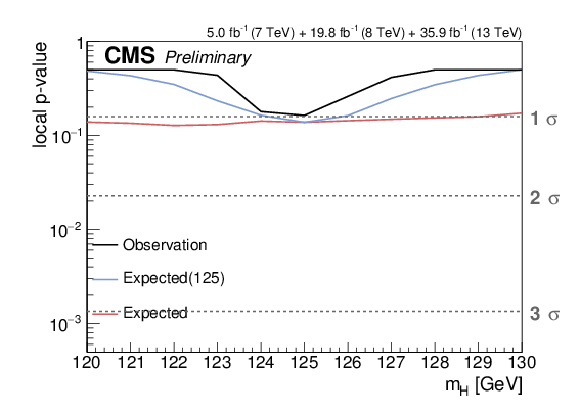
png pdf |
Figure 5-b:
The 95% CL upper limit on the signal strength modifier, $\mu $, for the combination of the 7, 8, and 13 TeV datasets (left) together with the expected limit obtained background hypothesis and in the signal-plus-background hypothesis (red-line) for a SM Higgs boson with $ {m_\mathrm{H}}= $ 125 GeV. The combined local p-value and significance as a function of the SM Higgs boson mass hypothesis (right). The observation (black) is compared to the expectation (red) for the Higgs boson, and (blue) for the Higgs boson mass of 125 GeV. |
| Tables | |
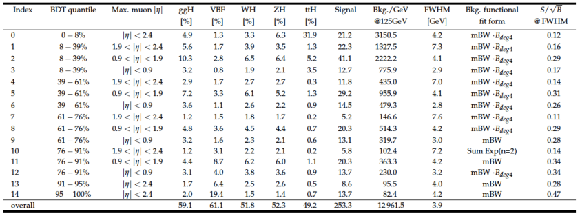
png pdf |
Table 1:
The optimized event categories, the product of acceptance and selection efficiency ($A\epsilon $) in% for the different production processes, the expected number of SM signal events ($ {m_\mathrm{H}} = $ 125 GeV), the estimated number of background events at 125 GeV, the full width at half maximum (FWHM) of the signal peak, the background functional fit form as explained in the text and the $S/\sqrt {B}$ within FWHM. |
| Summary |
| The combination of the present results with data recorded earlier at center-of-mass energies of 7 and 8 TeV yields a 95% CL observed (expected) upper limit on the production rate of 2.64 (1.89) times the SM value. Theoretical uncertainties are considered correlated across the datasets, while the main experimental uncertainties are considered uncorrelated. The best fit signal strength is obtained for a Higgs mass of 125 GeV, $ \hat{\mu}^{\text{comb}}_{125} = $ 0.9${}^{+1.0}_{-0.9}$, and the observed (expected) combined significance at $m_{\mathrm{H}} = $125 GeV is 0.98 (1.09)$\sigma$. This corresponds to an upper limit on the $ \mathrm{H} \to \mu^{+}\mu^{-}$ branching fraction of 5.7$\times 10^{-4}$, assuming the SM production cross sections. |
| References | ||||
| 1 | ATLAS Collaboration | Observation of a new particle in the search for the Standard Model Higgs boson with the ATLAS detector at the LHC | PLB716 (2012) 1--29 | 1207.7214 |
| 2 | CMS Collaboration | Observation of a new boson at a mass of 125 GeV with the CMS experiment at the LHC | PLB716 (2012) 30--61 | CMS-HIG-12-028 1207.7235 |
| 3 | ATLAS, CMS Collaboration | Combined Measurement of the Higgs Boson Mass in $ pp $ Collisions at $ \sqrt{s}= $ 7 and 8 TeV with the ATLAS and CMS Experiments | PRL 114 (2015) 191803 | 1503.07589 |
| 4 | F. Englert and R. Brout | Broken Symmetry and the Mass of Gauge Vector Mesons | PRL 13 (1964) 321--323 | |
| 5 | P. W. Higgs | Broken symmetries, massless particles and gauge fields | PL12 (1964) 132--133 | |
| 6 | P. W. Higgs | Broken Symmetries and the Masses of Gauge Bosons | PRL 13 (1964) 508--509 | |
| 7 | P. W. Higgs | Spontaneous Symmetry Breakdown without Massless Bosons | PR145 (1966) 1156--1163 | |
| 8 | CMS Collaboration | Observation of the Higgs boson decay to a pair of tau leptons | Submitted to PLB (2017) | CMS-HIG-16-043 1708.00373 |
| 9 | G. F. Giudice and O. Lebedev | Higgs-dependent Yukawa couplings | PLB665 (2008) 79--85 | 0804.1753 |
| 10 | A. Dery, A. Efrati, Y. Hochberg, and Y. Nir | What if BR$ (h\rightarrow\mu\mu) $/BR$ (h\rightarrow\tau\tau) $ does not equal $ m_{\mu^{2}}/m_{\tau^{2}} $? | JHEP 05 (2013) 039 | 1302.3229 |
| 11 | LHC Higgs Cross Section Working Group Collaboration | Handbook of LHC Higgs Cross Sections: 4. Deciphering the Nature of the Higgs Sector | 1610.07922 | |
| 12 | ATLAS Collaboration | Search for the Standard Model Higgs boson decay to $ \mu^{+}\mu^{-} $ with the ATLAS detector | PLB738 (2014) 68--86 | 1406.7663 |
| 13 | CMS Collaboration | Search for a standard model-like Higgs boson in the $ \mu^+\mu^- $ and $ e^+e^- $ decay channels at the LHC | PLB744 (2015) 184--207 | CMS-HIG-13-007 1410.6679 |
| 14 | ATLAS Collaboration | Search for the dimuon decay of the Higgs boson in $ pp $ collisions at $ \sqrt{s} = $ 13 TeV with the ATLAS detector | PRL 119 (2017), no. 5, 051802 | 1705.04582 |
| 15 | CMS Collaboration | The CMS experiment at the CERN LHC | JINST 3 (2008) S08004 | CMS-00-001 |
| 16 | CMS Collaboration | The CMS trigger system | JINST 12 (2017), no. 01, P01020 | CMS-TRG-12-001 1609.02366 |
| 17 | CMS Collaboration | Particle-flow reconstruction and global event description with the CMS detector | Submitted to JINST (2017) | CMS-PRF-14-001 1706.04965 |
| 18 | CMS Collaboration | Performance of the CMS muon detector and reconstruction with $ pp $ collisions at $ \sqrt{s} = $ 13 TeV | CMS-PAS-MUO-16-001 | |
| 19 | M. Cacciari, G. P. Salam, and G. Soyez | The anti-$ k_t $ jet clustering algorithm | JHEP 04 (2008) 063 | 0802.1189 |
| 20 | M. Cacciari, G. P. Salam, and G. Soyez | FastJet user manual | EPJC 72 (2012) 1896 | 1111.6097 |
| 21 | M. Cacciari, G. P. Salam, and G. Soyez | The anti-$ k_t $ jet clustering algorithm | JHEP 04 (2008) 063 | 0802.1189 |
| 22 | M. Cacciari, G. P. Salam, and G. Soyez | FastJet user manual | EPJC 72 (2012) 1896 | 1111.6097 |
| 23 | CMS Collaboration | Jet energy scale and resolution in the CMS experiment in pp collisions at 8 TeV | JINST 12 (2017), no. 02, P02014 | CMS-JME-13-004 1607.03663 |
| 24 | CMS Collaboration Collaboration | Jet algorithms performance in 13 TeV data | CMS-PAS-JME-16-003 | |
| 25 | P. Nason | A new method for combining NLO QCD with shower Monte Carlo algorithms | JHEP 11 (2004) 040 | hep-ph/0409146 |
| 26 | J. Alwall et al. | The automated computation of tree-level and next-to-leading order differential cross sections, and their matching to parton shower simulations | JHEP 07 (2014) 079 | 1405.0301 |
| 27 | J. Alwall et al. | MadGraph 5 : Going Beyond | JHEP 06 (2011) 128 | 1106.0522 |
| 28 | P. Artoisenet, R. Frederix, O. Mattelaer, and R. Rietkerk | Automatic spin-entangled decays of heavy resonances in Monte Carlo simulations | JHEP 03 (2013) 015 | 1212.3460 |
| 29 | T. Sjostrand, S. Mrenna, and P. Z. Skands | A Brief Introduction to PYTHIA 8.1 | CPC 178 (2008) 852--867 | 0710.3820 |
| 30 | CMS Collaboration | Event generator tunes obtained from underlying event and multiparton scattering measurements | EPJC76 (2016), no. 3, 155 | CMS-GEN-14-001 1512.00815 |
| 31 | GEANT4 Collaboration | GEANT4: A Simulation toolkit | NIMA506 (2003) 250--303 | |
| 32 | R. Gavin, Y. Li, F. Petriello, and S. Quackenbush | FEWZ 2.0: A code for hadronic Z production at next-to-next-to-leading order | CPC 182 (2011) 2388--2403 | 1011.3540 |
| 33 | M. Czakon and A. Mitov | Top++: a program for the calculation of the top-pair cross-section at hadron colliders | CPC 185 (Dec, 2011) 2930 | |
| 34 | P. Kant et al. | HatHor for single top-quark production: Updated predictions and uncertainty estimates for single top-quark production in hadronic collisions | CPC 191 (2015) 74--89 | 1406.4403 |
| 35 | M. Aliev et al. | HATHOR: HAdronic Top and Heavy quarks crOss section calculatoR | CPC 182 (2011) 1034--1046 | 1007.1327 |
| 36 | CMS Collaboration | Identification of b-quark jets with the CMS experiment | JINST 8 (2013) P04013 | CMS-BTV-12-001 1211.4462 |
| 37 | A. Hocker et al. | TMVA - Toolkit for Multivariate Data Analysis | PoS ACAT (2007) 040 | physics/0703039 |
| 38 | CMS Collaboration | Performance of CMS muon reconstruction in pp collision events at $ \sqrt{s} = $ 7 TeV | JINST 7 (2012) P10002 | |
| 39 | CMS Collaboration | Observation of the diphoton decay of the Higgs boson and measurement of its properties | EPJC74 (2014), no. 10 | CMS-HIG-13-001 1407.0558 |
| 40 | CMS Collaboration | CMS Luminosity Measurements for the 2016 Data Taking Period | CMS-PAS-LUM-17-001 | CMS-PAS-LUM-17-001 |
| 41 | ATLAS Collaboration, CMS Collaboration, LHC Higgs Combination Group | Procedure for the LHC Higgs boson search combination in Summer 2011 | CMS-NOTE-2011-005 | |

|
Compact Muon Solenoid LHC, CERN |

|

|

|

|

|

|